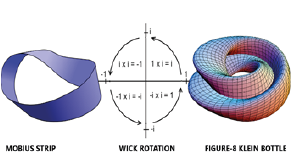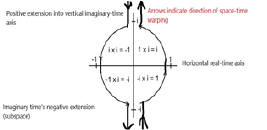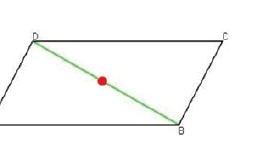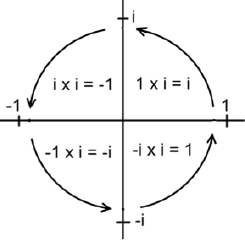In 1982, MIT physicist Frank Wilczek predicted and named ANYONS, quasiparticles (particle-like formations) that are confined to 2 dimensions and were discovered in 2020. The name might come from Prof. Wilczek's lighthearted comment "anything goes". This article's main goal is to show that anyons could be another name for 1) virtual particles, 2) Mobius strips, and 3) figure-8 Klein bottles. Along the way, we'll see the picture painted by the article confirm that Einstein's dream of gravitational-electromagnetic unity fits in with anyons being Mobius strips. The topological hypothesis offers an explanation of dark matter and dark energy. We'll also have encounters with intergalactic travel and imaginary computers. They really could exist but are imaginary in the sense that they use imaginary time (as well as space-time warping).
Anyon, Gravitational-Electromagnetic Unification, Topological Universe, Intergalactic Travel, Future Computers, Dark Matter/Dark Energy, Quaternions, Spinors, Wick rotation, Vector-tensor-scalar geometry
What's a method that suggests the unifying of gravitation and electromagnetism? Electronics' binary digits can be used to draw a two-dimensional computer image of a Mobius strip. Two united Mobius strips create a three-dimensional figure-8 Klein bottle [1] that acts as a building block of space, time, forces’ bosons and matter’s fermions. This creates a supersymmetry (linkage) between fermions and bosons. A recent paper [2] says that in a holographic universe, all of the information in the universe is contained in two-dimensional packages trillions of times smaller than an atom (in this case, the 2D package is the Mobius Strip). If it's assumed from supersymmetry that the Mobius contains all the information in both fermionic and bosonic particles, trillions of Mobius strips could form a photon and trillions of more complex figure-8 Klein bottles could form a more complex graviton (suggesting union of electromagnetism and gravitation).

Figure 1: Mobius/Wick/Klein
The physicist and science historian Abraham Pais wrote that “In 1924 the scientist Wolfgang Pauli was the first to propose a doubling of electron states due to a two-valued non-classical "hidden rotation" [3].
Extending the ideas of “doubling”, “two-valued” and “hidden rotation” to the Mobius strip being a basic, fundamental unit of reality; it can be seen that Pauli’s proposal has an analogy to this article. The doubled Mobius strips (doubled to form a figure-8 Klein bottle) could be produced by the two-valued binary-digit system used in electronics. The bottles possess a hidden rotation, now identified as adaptive Wick rotation, which gives a fourth dimension to space-time.
The above paragraphs suggest we should follow Einstein's example and not be in favor of a 4 dimensional model but concede to its use to help mathematicians address the calculations necessary to explain general or special relativity [4].
Also, they imply that the universe we live in needn't be described as 3 spatial dimensions plus one temporal dimension (3+1 space-time) but, in keeping with the theory of a holographic universe’s 3 spatial dimensions being a projection from 2 dimensional information, as 2+1 space-time. The universe's foundation wouldn't rest on particles then but on what physics calls quasiparticles: particle-like objects which exhibit exotic behaviours and may, according to this article's next paragraphs, be identified as Mobius strips and figure-8 Klein bottles (see figure 1).
According to physics, the electric repulsive force between 2 electrons is due to the exchange of "virtual" photons (undetectable particles which nevertheless have measurable effects on "real", detectable particles). When 2 electrons move past each other, real photons may be emitted. Logically, the real photons must be composed of the pre-existing virtual photons. If it's recalled that photons were described as being composed of trillions of Mobius strips (just before Diagram 1), we conclude that virtual particles are Mobius strips. Or they're more complex figure-8 Klein bottles, when 2 Strips combine to form a more complex Bottle. Trillions of Bottles form the complicated, elusive graviton.
You need to journey round a Mobius twice (make 2 revolutions) to return to the starting point. So if 1 anyon (a 3rd type of particle discovered in 2020, and possibly a Mobius strip or figure-8 Klein bottle according to this article) moves round another, return to the original quantum state can only occur after 3 revolutions - the 2 required to return a Mobius to its start plus the complete revolution of one moving around the other. If the particle under study is a figure-8 Klein bottle, then the revolution of one about the other is supplemented by 4 revs (you go round each of the 2 combined Strips twice), and 5 revs must be completed before return to the original quantum state is achieved. (Physics' theories about anyons predict these revs regarding the quantum state.)
About time and the property called distance between 3 dimensional objects (assuming the universe is holographic and actually resides in 2+1 space-time) -As stated in a robotics lesson, [5] "the time variable t varies from 0 to 1, that is, 0 ≤ t ≤ 1". Therefore, this article’s logic states that 0 may be equal to 1 (division by 1 is accepted, so why isn't division by 0?) Since time is permanently united with space in physics, 0=1 in space-time too. This is consistent with a proposed future theory of physics called Quantum Gravity; where Quantum Mechanics is united with General Relativity, Einstein's theory of gravity. A possible path to attainment of quantum gravity is realizing that all objects and events on Earth and in space-time are just one thing - like 0 equalling 1, and like the objects in a computer image seeming to be a lot of separate objects but really just being one thing (strings of the binary digits 1 and 0, which can represent electrical pulses being "on" or "off"). A spacecraft sitting on its launchpad can be assigned t=0, and its destination t=1. Since 0=1, reaching the destination takes the same time as reaching the launchpad from the craft’s position on the launchpad (travel is instant).
(The distance to the ship's destination and the time to arrive both equal zero.)
The preceding paragraph can be given physical substance by the following experiment performed over a decade ago at Yale University:
Unifying gravitation and electromagnetism has this consequence: A 2009 electrical-engineering experiment at America's Yale University, together with the ideas of Albert Einstein, tells us how we could travel to other stars and galaxies. An electrical engineering team at Yale demonstrated that, on silicon-chip and transistor scales, light can attract and repel itself like electric charges or magnets [6].
This is the Optical Bonding Force. For 30 years until his death in 1955, Einstein worked on his Unified Field Theory with the aim of uniting electromagnetism (light is one form of this) and gravitation. Achievement of this means the quantum components (gravitons) of gravity/spacetime-warps between spaceships and stars could mimic the Optical Force and be attracted together, thereby eliminating distance (this, possibly acting in partnership with repulsion, could produce a wormhole, or shortcut between folds in space and time). If the gravitons are superposed and entangled, distances between both points in space and points in time are totally eliminated.

Figure 2: Going Beyond Quantum Computers with Imaginary Time and Spacetime Warping
Our present approach to developing computers has gone about as far it can. The problems of chips generate too much heat - and of quantum uncertainties making transistors hopelessly unreliable at the scale of atoms - demand a new approach. I'm proposing that the successor to today's silicon technology (and tomorrow's quantum computers) lies in new concepts of time. An "imaginary" computer using the Complex Number Plane's vertical axis of imaginary time can perform calculations at the familiar rate of time's passing while the horizontal axis of "real" time sees absolutely no elapsed time (the possibility of no time passing in the normal sense is hinted at by Special Relativity's time dilation or slowing of time). Referring to diagram 2, space-time is warped and the computer's processing is performed in imaginary time (possibly for trillions of years) - but space-time is warped again so the results can be retrieved in real time where no time at all has elapsed.
For a hundred and ten years, science has accepted the concept of space-time which was formulated by Russian-German mathematician Hermann Minkowski and unites one time dimension with three space dimensions. Today, so-called imaginary numbers (such as i, which equals √-1) describe so-called imaginary time. Imaginary time is a concept derived from special relativity and quantum mechanics. Geometrically, imaginary numbers are found on the vertical axis of the Complex Number Plane, allowing them to be presented perpendicular to the real axis of space-time as we know it. One way of viewing imaginary numbers is to consider a standard number line, positively increasing in magnitude to the right, and negatively increasing in magnitude to the left. At 0 on this x-axis (the so-called real axis), a y-axis (the so-called imaginary axis) can be drawn with "positive" direction going up - "positive" imaginary numbers then increase in magnitude upwards, and "negative" imaginary numbers increase in magnitude downwards.
The ultraviolet catastrophe, also called the Rayleigh–Jeans catastrophe, is a failure of classical physics to predict observed phenomena: it can be shown that a blackbody - a hypothetical perfect absorber and radiator of energy - would release an infinite amount of energy, contradicting the principles of conservation of energy and indicating that a new model for the behaviour of blackbodies was needed. At the start of the 20th century, physicist Max Planck derived the correct solution by making some strange (for the time) assumptions. In particular, Planck assumed that electromagnetic radiation can only be emitted or absorbed in discrete packets, called quanta. Albert Einstein postulated that Planck's quanta were real physical particles (what we now call photons), not just a mathematical fiction. From there, Einstein developed his explanation of the photoelectric effect (when quanta or photons of light shine on certain metals, electrons are released and can form an electric current). So it appears entirely possible that another supposed mathematical trickery (imaginary time) will find practical application in the future in the form of Imaginary Computers.
Dark Matter and Dark Energy
The electromagnetic and gravitational waves composing space-time rotate in a cycle. The waves rotate through the vertical y-axis* that is home to so-called Dark Matter and the Dark Energy composing it, and back to the horizontal x-axis' space-time. (As NASA’s measurements reveal in the next paragraph, the composition of dark matter by dark energy isn’t as simple as energy=mass in all cases i.e. it isn’t always similar to ordinary energy composing ordinary matter via E=mc^2.) Since quantum mechanics says particles can be in two or more places at once, the photons and gravitons which make up the waves in space-time can be on the x- and y-axes simultaneously and thus interfere with themselves, causing time to slow down significantly near the speed of light in a vacuum or under intense gravity.
*The dark matter/dark energy (DM/DE) residing at or near the Complex Number Plane’s y axis remains in space-time's curves (in gravity) so it gravitationally affects space-time on the x axis. But this exotic mass-energy lies perpendicular (or almost perpendicular) to each dimension of our instruments, and thus electromagnetically undetectable (at least at present). 5.5 rotations, each of ~ 65.45 degrees, means there would be 5 1/2 times as much dark matter as ordinary matter (or, to use NASA's number in [7], about 27% of the universe would be DM). Constant rotation keeps the x- and y-axes interactive but doesn't make more ordinary matter since the x-axis is restricted to E=mc^2 (the amount of available energy limits the production of matter). Mass-energy equivalence may not be DE=DMc^2 in every "dark" dimension. In some, there might be more "dark" energy available. It'd be possible for the universe to contain more than 5.5 times as much energy as our dimension. DE could be roughly 68% of the content of the cosmos.
Quaternions, Spinors and Wick Rotation Related to Two-Dimensional Vector-Tensor-Scalar (Vts) Geometry
“Dust grains assemble by chemical bonding. Once they are sand or gravel sized, how they continue to stick is a mystery. Metre-sized rocks should spiral into the star rapidly due to disc drag (the gas orbits a little slower than the rocks as a pressure gradient partially supports it). Once rocks somehow get past these barriers, they collide with each other in a chaotic and random way assembling the planets.” Australian National University (2012-2019).
The following method of building planets is preferred to collisions between rocks and dust in the disc because most planetary systems seem to outweigh the protoplanetary discs in which they formed, leaving astronomers to re-evaluate planet-formation theories. Astronomy (2019)

Figure 3: VTS (VECTOR-TENSOR-SCALAR) GEOMETRY - Interaction of Gravitation and Electromagnetism Produces a Momentum in Gravitons and Photons (and a Pressure which is known as Mass). VTS Geometry inspired by Einstein (1919)
A vector is a quantity which possesses both magnitude and direction. Two such quantities acting on a point may be represented by two adjoining sides of a parallelogram, so that their resultant is represented in magnitude and direction by the diagonal of the parallelogram (AD and CD, for example, can symbolize the electromagnetic and gravitational vectors … while the resultant green diagonal of DB substitutes for the interaction of those two forces). A scalar variable is representable by a position on a line, having only magnitude e.g. the red dot on the diagonal, symbolic of the Higgs boson. A tensor is a set of functions which, when changing from one set of coordinates to another, are transformed in a precisely defined manner (e.g. changing from the coordinates of AD and CD to those of the green diagonal, or of the red dot, is a transformation performed in a particular way). Adapted from Macquarie (2001).
Two sides thus illustrate the graviton's spin 2 and the photon's spin 1. The resultant diagonal represents the interaction of the sides/vectors (1÷2 = the spin ½ of every matter particle). Tensor calculus changes the coordinates of the sides and diagonal into the coordinates of a single (scalar) point on the diagonal. This scalar point is associated with particles of spin 0. Klauber (2018) If the mass produced during the photon-graviton interaction (the energy and momentum of photons and presently hypothetical gravitons produces a pressure we call mass*) happens to be 125 GeV/c^2, its union with spin 0 produces the Higgs boson. 125 GeV/c2 united with spin 0 means the central scalar point of the Higgs boson is related to the vector of the graviton’s spin 2, and the Higgs field is therefore united with the supposedly unrelated gravitational field (together with the latter’s constant interaction with the electromagnetic field).

Figure 4: WICK ROTATION: “The complex plane reveals i’s special relationship with cycles via the circle of i, also known as Wick rotation. Whenever a point on the complex plane is multiplied by i, it moves a quarter rotations around the origin or center of the plane” [8].
Quaternions were first described by Irish mathematician William Rowan Hamilton in 1843. Hamilton defined a quaternion as the quotient of two vectors. (Hardy: 1881) In this case: the quotient of two vectors is 1/2, the division of the electromagnetic vector (photonic quantum spin of 1) by the gravitational vector (gravitonic quantum spin of 2). In other words, the term "diagonal" in VTS Geometry can be replaced with the term "quaternion". And the counterclockwise rotation of the (horizontal) x- and (vertical) y-axes in Wick Rotation can be viewed as either rotation into diagonal form or as a quaternion function [8].
Spinors - elements of a complex vector space that were introduced in geometry by Élie Cartan in 1913 (Cartan 1913) - can be viewed as the "square roots" of vectors. This indicates that spinors are a guide to the mathematical interactions between gravitation and electromagnetism outlined by the gravitational and electromagnetic vectors of Vector-tensor-scalar geometry.
Extra Dimensions and Space-Time Warping
To introduce you to the idea of extra dimensions, consider this – Professor Itzhak Bars of the University of Southern California in Los Angeles says, one whole dimension of time and another of space have until now gone entirely unnoticed by us [9].
The temporal dimension would be "imaginary" time and the spatial dimension would be "imaginary" space, which must exist since time cannot exist apart from space (just as there is space-time, there would be imaginary space-time). Now suppose engineers warp space-time so the functioning of a computer's processor takes place in so-called imaginary time. If warping is looped so results emerge in so-called real time, its calculations would be retrieved instantly after they were entered into the computer because billions of years might pass in imaginary time yet no period at all could elapse in our real time. These warps and loops are viable because they're inspired by Einstein's Special Relativity – and propose the use of space-time warping which, though in its infancy, is a technology being worked on today by places like NASA.
USA theoretical physicist Ronald Mallett is also doing experimental work on space-time warping (gravitational warping, since General Relativity defines gravity as the warps and curves in space-time) for the purpose of developing scientific time travel. He describes his work - called the Space-time Twisting by Light (STL) project - in [10].
"In Einstein's General Theory of Relativity, both matter and energy can create a gravitational field. This means that the energy of a light beam can produce a gravitational field. My current research considers both the weak and strong gravitational fields produced by a single continuously circulating unidirectional beam of light. In the weak gravitational field of an unidirectional ring laser, it is predicted that a spinning neutral particle, when placed in the ring, is dragged around by the resulting gravitational field" [11-16].
- Polthier, K (2003) Imaging maths - Inside the Klein bottle".
- Afshordi, N., Corianò, C., Delle Rose, L., Gould, E., Skenderis, K (2017) From Planck Data to Planck Era: Observational Tests of Holographic Cosmology. Phys. Rev. Lett. 118, 041301.
- Pais, A (1991) Niels Bohr's Times. Oxford: Clarendon Press 201.
- Rajabi, L. https://www.researchgate.net/messages/53816668
- Corke, P (2019) Queensland University of Technology. MATLAB: Interpolation of a scalar.
- Li (2009) “Tunable bipolar optical interactions between guided lightwaves” by Mo Li, W. H., P. Pernice., H. X. Tang, Nature Photonics 3: 464-468.
- NASA (2019) "NASA SCIENCE - Dark Energy, Dark Matter",
- Welch (2015) “The Meaning of Imaginary Time: Creativity’s Dialog with Timelessness” by Kerri Welch (public domain figure supplied by WordPress),
- Tom Siegfried (2007) A Two-Time Universe? Physicist Explores How Second Dimension of Time Could Unify Physics Laws.
- Mallett, R. L (2000). Weak gravitational field of the electromagnetic radiation in a ring laser". Phys. Lett. A. 269: 214.
- Astronomy (2019)”AstroNews”, February, p. 17
- Einstein (1919) “Spielen Gravitationfelder im Aufbau der Elementarteilchen eine Wesentliche Rolle?” [Do gravitational fields play an essential role in the structure of elementary particles?] by Albert Einstein, Sitzungsberichte der Preussischen Akademie der Wissenschaften, [Math. Phys.] 349-356.
- Macquarie (2001) "Vector", "Tensor" and "Scalar", The Macquarie Concise Dictionary.
- Robert D. Klauber (2018) “Scalars: Spin 0 Fields”.
- Arthur Sherburne Hardy (1881) "Elements of Quaternions".
- Cartan (1913) "Les groupes projectifs qui ne laissent invariante aucune multiplicité plane". Bull. Soc. Math. Fr 41: 53-96.




